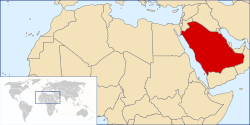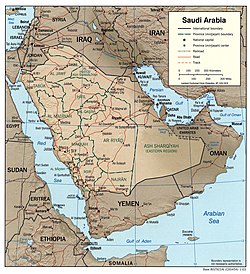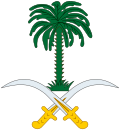

The following outline is provided as an overview of and topical guide to Saudi Arabia:
Contents
- General reference
- Geography of Saudi Arabia
- Environment of Saudi Arabia
- Regions of Saudi Arabia
- Demography of Saudi Arabia
- Government and politics of Saudi Arabia
- Branches of the government of Saudi Arabia
- Foreign relations of Saudi Arabia
- Law and order in Saudi Arabia
- Military of Saudi Arabia
- Local government in Saudi Arabia
- History of Saudi Arabia
- Culture of Saudi Arabia
- Art in Saudi Arabia
- Sports in Saudi Arabia
- Economy and infrastructure of Saudi Arabia
- Education in Saudi Arabia
- See also
- References
- External links
Saudi Arabia is a sovereign country that comprises the central portion of the Arabian Peninsula of Southwest Asia. [1] It is bordered by Jordan on the northwest, Iraq on the north and northeast, Kuwait, Qatar, and the United Arab Emirates on the east, Oman on the southeast, and Yemen on the south. The Persian Gulf lies to the northeast and the Red Sea to its west. It has an estimated population of 34,218,169, and its size is approximately 2,150,000 square km (830,000 square miles). [2]
The Kingdom is sometimes called "The Land of The Two Holy Mosques" in reference to Mecca and Medina, the two holiest places of Islam. The Kingdom was founded by Abdul-Aziz bin Saud, whose efforts began in 1902 when he captured the Al-Saud's ancestral home of Riyadh, and culminated in 1932 with the proclamation, and recognition of the Kingdom of Saudi Arabia.
Saudi Arabia is the world's leading petroleum exporter and petroleum exports fuel the Saudi economy. [3] Oil accounts for more than 90 percent of exports and nearly 75 percent of government revenues, facilitating the creation of a welfare state, [4] [5] which the government has found difficult to fund during periods of low oil prices. [6] Human rights groups such as Amnesty International and Human Rights Watch have repeatedly expressed concern about the state of human rights in Saudi Arabia, although these concerns have been dismissed by the Saudi government.





